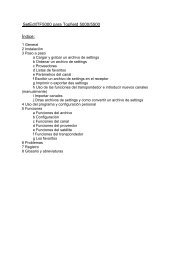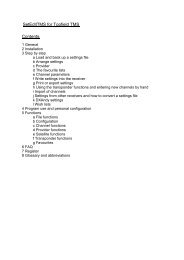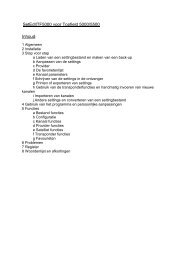SetEditFDU-HD for FDU-receiver and compatible Contents:
SetEditFDU-HD for FDU-receiver and compatible Contents:
SetEditFDU-HD for FDU-receiver and compatible Contents:
Create successful ePaper yourself
Turn your PDF publications into a flip-book with our unique Google optimized e-Paper software.
5.b Configuration<br />
Click on the "Config." button to change the general settings of SetEdit. There are three tab sheets in<br />
the configuration menu.<br />
General settings:<br />
If you click on "General settings" you get the following menu:<br />
The value Frequ. Tol. (Frequency tolerance) is used when importing <strong>and</strong> indicates the tolerance a<br />
transponder frequency may have relative to the imported one to be considered to be the same. If you<br />
have <strong>for</strong> example a transponder with the frequency 11721 MHz in you settings <strong>and</strong> you import a<br />
channel with the frequency 11720 MHz <strong>and</strong> the frequency tolerance is set to 5 MHz no new<br />
transponder is created. This tolerance is also used <strong>for</strong> the transponder list.<br />
With Column width you can select if 100% (auto) or 90-30% of all channels have to fit completely to a<br />
column. All other channel names are truncated. With "manual" you can enter the column width by<br />
h<strong>and</strong>. Please select the function "Setup column width" from the menu of the channel lists <strong>and</strong> then you<br />
can click on the position where you want to have the right border of the first column.<br />
Note: There is a minimum width <strong>for</strong> the columns. If the window is too small to show more than one<br />
column the column width has no effect.<br />
With Baud rate you change the speed <strong>for</strong> serial communication (see chapter 3.a).<br />
In the field Cut names you can enter, if channel names that are too long (see column width), are cut at<br />
the end or in the middle.<br />
In the field PIDs you select how the PIDs are shown/entered (decimal or hexadecimal). You can also<br />
switch between these two viewing modes, if you click on the "H" <strong>for</strong> hexadecimal or the "D" <strong>for</strong> decimal<br />
in the frame of the "In<strong>for</strong>mation" section.<br />
With Language you can select the menu language you would like. This language is taken <strong>for</strong> all<br />
opened SetEdit windows.<br />
With Always on top <strong>SetEdit<strong>FDU</strong></strong>-<strong>HD</strong> always stays on top of your desktop.<br />
With Names: short you will get the short names of the channels in the channel list (see chapter 3.d).<br />
With Start with last used file <strong>SetEdit<strong>FDU</strong></strong>-<strong>HD</strong> opens automatically the last used file every time you<br />
start the program.<br />
With When loading use personal sat settings you can, after you have once saved your satellite<br />
configuration (see chapter 3.i), use this configuration automatically when loading settings. For example<br />
you can use your satellite settings always when you load settings from other sources.<br />
If Restore last session when starting is activated, all editor windows that were opened when you<br />
closed the last session are reopened (see chapter 5.a.)






